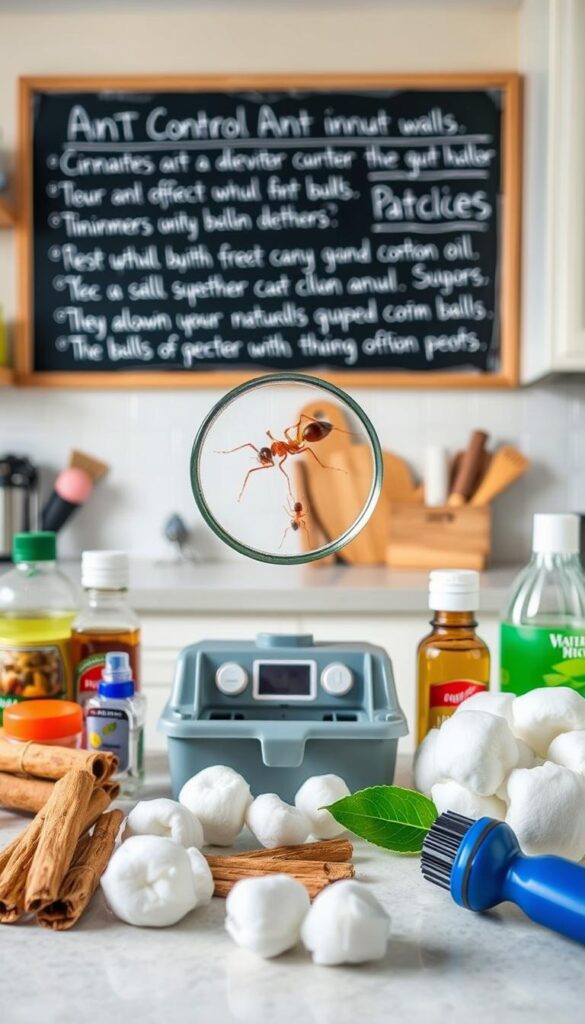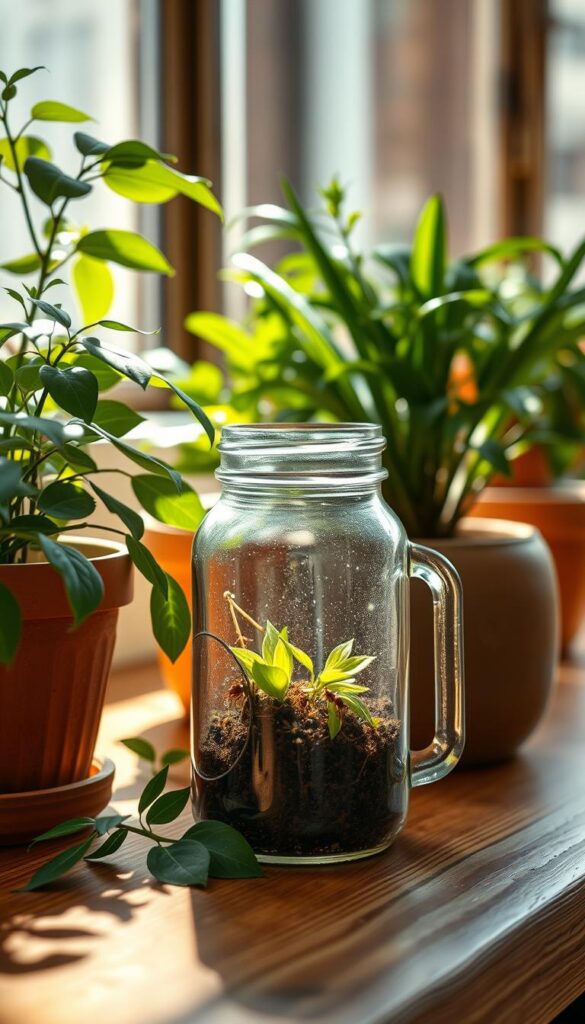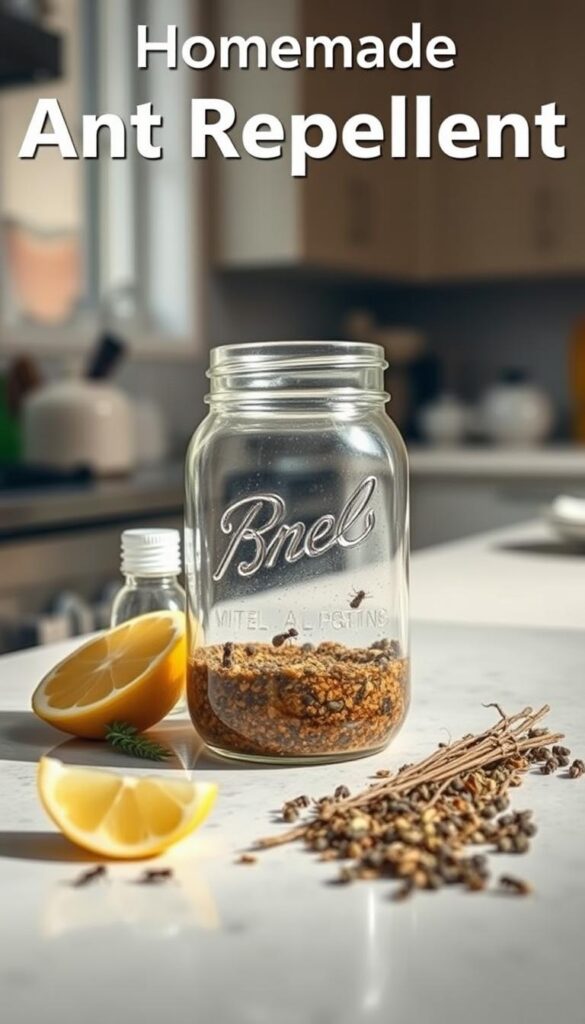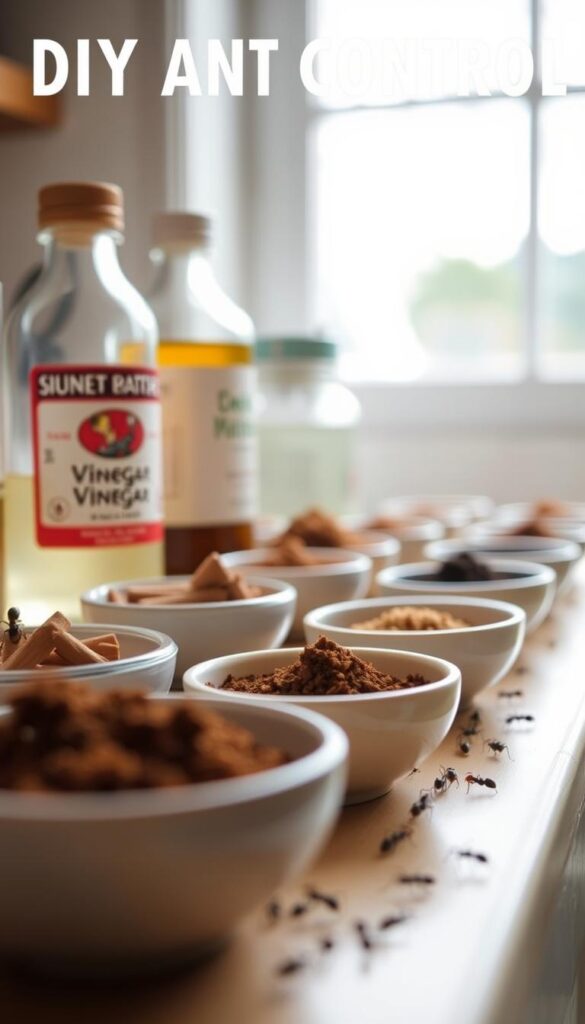As I watched ants march across my kitchen counter, I knew I had to do something. It was not just annoying but a sign of a bigger problem. So, I decided to make my own homemade ant killer indoor using natural stuff.
This method is not only cheap but also keeps me away from harmful chemicals in store-bought products. By using things I already have at home, I made an indoor ant deterrent that’s safe and works well.
Key Takeaways
- Natural ingredients can be used to create effective ant repellents.
- Homemade solutions are cost-effective and avoid harsh chemicals.
- Common household items can be repurposed as indoor ant deterrents.
- Creating your own ant repellent is a simple and efficient process.
- Using homemade ant repellents can help keep your home ant-free.
Why Ants Invade Your Home and How to Spot an Infestation
It’s important to know why ants come into your home. They are drawn to food, water, and places to hide. This makes homes perfect for them to live.
Common Types of Household Ants in the US
In the US, you’ll find many types of ants in homes. There are odorous house ants, pavement ants, and carpenter ants. Odorous house ants smell bad. Pavement ants live in soil and under pavement. Carpenter ants can damage your home’s structure.

Signs You Have an Ant Problem
How do you know if ants are a problem? Look for ant trails leading to food. You might see discarded wings or small piles of dirt near nests. If ants are in your kitchen or near food, you have ants.
Understanding Ant Behavior and Entry Points
Ants can get into your home through tiny openings. They like sweet or sticky things and moisture. To keep ants out, know their habits and block their entry points. A natural ant repellent recipe can also help.
By understanding ants and how to spot them, you can start to control them. This is the first step to keeping ants out of your home.
The Problems with Commercial Ant Repellents
Commercial ant repellents might seem like a quick solution. But they can harm our families, pets, and the environment. They might stop ants for a while, but the long-term dangers are real.
Chemical Concerns for Families and Pets
Many commercial ant repellents have harsh chemicals. These can hurt children and pets. They can stay in the air, on surfaces, and on our skin, posing health risks.
Some products have neurotoxins that can harm our nervous systems. Choosing a non-toxic ant repellent is safer for homes with kids and pets.
Environmental Impact of Commercial Products
The environmental impact of commercial ant repellents is big. Their chemicals can pollute soil, water, and air. This harms our planet.
By picking eco-friendly ant repellent options, we can lessen our environmental harm.
| Aspect | Commercial Ant Repellents | Eco-Friendly Alternatives |
|---|---|---|
| Chemical Safety | Often contains harsh chemicals | Non-toxic and safe for families and pets |
| Environmental Impact | Can contaminate soil, water, and air | Eco-friendly, reducing ecological footprint |
Knowing the problems with commercial ant repellents helps us make better choices. Making a homemade ant bait indoor solution is effective and safer for our homes and the planet.

Benefits of Using DIY Ant Repellent Indoor Solutions
Choosing DIY ant repellents can change the game for homeowners. They offer a cost-effective and safe way to fight ants. Unlike commercial products, they don’t have harsh chemicals.

Cost-Effectiveness of Homemade Solutions
DIY ant repellents are very affordable. They use common items like vinegar, cinnamon, and essential oils. These are often cheaper than store-bought products.
Key cost-saving benefits include:
- Utilizing pantry staples to create repellents
- Avoiding the need for expensive commercial products
- Reducing waste by using items you already have at home
Safety for Children and Pets
DIY ant repellents are safer for kids and pets than commercial ones. They use natural ingredients. For example, peppermint oil can keep ants away without harming family or pets.
Eco-Friendly Advantages
Homemade ant repellents are better for the environment. Commercial products can harm the earth and wildlife. DIY repellents use biodegradable ingredients, making them gentler on the planet.
Essential Ingredients for Natural Ant Repellents
To keep ants away without harsh chemicals, knowing key ingredients is crucial. A good natural ant repellent recipe uses what ants don’t like. This helps keep them out.
Pantry Staples That Repel Ants
Many pantry items can keep ants away. They’re safe for kids and pets, making them perfect for a homemade ant killer indoor solution.
Vinegar
Vinegar is a strong ant deterrent. Its smell confuses ants, making it hard for them to find their way. Mix equal parts vinegar and water in a spray bottle for a great repellent.
Lemon Juice
Lemon juice also keeps ants away. Its acidity and citrus scent repel them. Mix lemon juice with water and spray it where ants enter.
Cinnamon
Cinnamon is nice for us but not for ants. Sprinkle cinnamon powder where ants are seen to keep them away.
Black Pepper
Black pepper is another spice ants don’t like. Sprinkle it where ants are seen to keep them out.

Essential Oils That Deter Ants
Certain essential oils also repel ants. These oils are strong and should be diluted with water or a carrier oil.
Peppermint Oil
Peppermint oil is a strong ant repellent. Mix a few drops with water and spray it to keep ants away.
Tea Tree Oil
Tea tree oil has antimicrobial properties and repels ants. Use it diluted with water or a carrier oil to keep ants away.
Clove Oil
Clove oil is another effective ant repellent. Its scent disrupts ant trails and keeps them out.
Eucalyptus Oil
Eucalyptus oil is known for its decongestant properties and repels ants. Mix it with water and spray it where ants enter.
| Ingredient | Form | Application |
|---|---|---|
| Vinegar | Liquid | Mix with water, spray around entry points |
| Lemon Juice | Liquid | Mix with water, spray around entry points |
| Cinnamon | Powder | Sprinkle along ant trails and entry points |
| Peppermint Oil | Essential Oil | Mix with water, spray around the home |
With these natural ingredients, you can make a safe and eco-friendly ant repellent. It keeps ants away without harming your family or pets.
My Favorite Ant Repellent DIY Indoor Spray Recipes
Let’s start making your own ant repellent sprays with simple, natural ingredients. Making your own DIY ant control indoors is both affordable and safe. It avoids harsh chemicals found in commercial products.
Vinegar and Essential Oil Spray
This spray uses vinegar and essential oils to keep ants away.
Ingredients Needed
- 1 cup of water
- 1/2 cup of white vinegar
- 10 drops of peppermint essential oil
- 10 drops of tea tree oil
Step-by-Step Mixing Instructions
- Mix water and vinegar in a spray bottle.
- Add the peppermint and tea tree essential oils.
- Shake the bottle well to combine.
Application Tips
Spray this mixture along ant trails, around entry points, and in areas where ants are spotted. Reapply every few days for best results.
Citrus Peel Repellent
Citrus peels can make a natural ant repellent that smells good.
Ingredients Needed
- Peels of 2 oranges or lemons
- 1 cup of water
- 1 tablespoon of white vinegar
Step-by-Step Mixing Instructions
- Boil the citrus peels in water for 10 minutes.
- Let it cool, then strain the mixture into a spray bottle.
- Add vinegar to the mixture.
Application Tips
Spray this repellent around the home, focusing on areas where ants are seen. The citrus scent will help deter ants.
Peppermint and Tea Tree Oil Solution
This solution is a strong mix of peppermint and tea tree oils. They are known for repelling ants.
Ingredients Needed
- 1 cup of water
- 15 drops of peppermint essential oil
- 15 drops of tea tree oil
Step-by-Step Mixing Instructions
- Mix water and essential oils in a spray bottle.
- Shake well to combine.
Application Tips
Spray this solution directly on ants and around entry points. Its strong scent will repel ants effectively.
Cinnamon and Clove Deterrent
Cinnamon and clove are spices that ants detest. They are perfect for a homemade ant repellent.
Ingredients Needed
- 1 cup of water
- 1 teaspoon of cinnamon powder
- 1/2 teaspoon of ground cloves
Step-by-Step Mixing Instructions
- Boil water and add cinnamon and cloves.
- Let it steep for a few hours, then strain into a spray bottle.
Application Tips
Spray this deterrent around the home, specially in areas where food is prepared or consumed. The strong aroma will keep ants away.
Homemade Ant Baits and Traps
Creating homemade ant baits and traps is a simple and effective way to manage ant infestations indoors. By using natural ingredients, you can avoid the chemicals found in commercial products. This makes your home safer for your family and pets.

Borax and Sugar Ant Bait
One of the most popular homemade ant baits is made using borax and sugar. The sweetness of the sugar attracts ants. The borax acts as a poison that they carry back to their colony, effectively killing the queen and eventually the rest of the ants.
Safety Precautions
When using borax, it’s essential to take safety precautions. Keep the bait away from children and pets, as ingesting borax can be harmful. Wear gloves when handling borax to avoid skin irritation.
Mixing Instructions
To make the bait, mix equal parts borax and sugar in a bowl. You can adjust the ratio based on the severity of your ant problem. Place the mixture in a shallow container or on a piece of cardboard near the areas where ants are seen.
Placement Strategy
Place the borax and sugar bait near ant trails and entry points. This will increase the chances of ants finding and carrying the bait back to their colony. Be patient, as it may take some time to see results.
Diatomaceous Earth Application
Diatomaceous earth is another effective tool in controlling ants. It works by dehydrating the ants, causing them to die.
What Is Diatomaceous Earth
Diatomaceous earth is a powder made from the fossilized remains of tiny aquatic organisms called diatoms. It’s non-toxic to humans and pets but deadly to ants and other insects.
Application Method
Sprinkle diatomaceous earth powder along ant trails, around entry points, and in areas where ants are seen. Make sure to wear a mask when applying to avoid inhaling the fine powder.
Safety Considerations
While diatomaceous earth is safe for humans and pets, it’s still important to avoid inhaling it. Keep it away from open wounds or sensitive areas.
Cornstarch Trap Method
The cornstarch trap is a simple and non-toxic method to capture ants. Mix cornstarch and water to form a paste, and place it in areas where ants are present. Ants are attracted to the paste and get trapped.
As stated by a pest control expert, “Using homemade ant baits and traps is not only cost-effective but also a safer alternative to chemical-laden commercial products.” This approach aligns with the goal of maintaining a safe and healthy home environment.
How to Apply Your Homemade Ant Repellents Effectively
To keep your home ant-free, it’s important to use your homemade ant repellents right. Knowing where and how to apply them can help a lot. This way, you can keep your home free from ants.
Identifying and Treating Ant Trails
Ants follow trails marked by pheromones. To use your repellents well, find these trails first. Look for lines of ants heading to food or nests. Then, spray or sprinkle your repellent along these trails to block their way.

Room-by-Room Application Guide
Every room needs a different approach because of different attractants and entry points.
Kitchen Application
In the kitchen, focus on countertops, sinks, and appliance areas where ants are common. Use a spray repellent with essential oils like peppermint or tea tree oil.
Bathroom Application
In bathrooms, ants are drawn to moisture. Spray repellents around sinks, toilets, and showers. A citrus-based spray works well here.
Living Areas and Bedrooms
In living areas and bedrooms, ants are near food or sweet things. Use a light dusting of diatomaceous earth or a cinnamon and clove deterrent in these spots.
| Room | Common Ant Attractants | Recommended Repellent |
|---|---|---|
| Kitchen | Food, spills, sweet substances | Peppermint or Tea Tree Oil Spray |
| Bathroom | Moisture, soap residue | Citrus-based Spray |
| Living Areas & Bedrooms | Food crumbs, sweet substances | Diatomaceous Earth or Cinnamon & Clove Deterrent |
Frequency of Application
How often you apply your repellents depends on the repellent type and the ant problem. Usually, reapply every few days or after cleaning. Being consistent is crucial for an ant-free home.
Preventing Future Ant Invasions
Keeping your home ant-free is more than just using repellents. It’s about understanding what attracts ants and taking action. This way, you can stop ants from coming back.
Kitchen and Food Storage Practices
Ants love food, so a clean kitchen is key. Clean countertops, sweep and mop floors, and seal food containers. Don’t forget to clean up crumbs and spills right away.
Using eco-friendly ant repellents in your kitchen can also help keep ants away.

Sealing Entry Points
Ants can sneak in through tiny cracks. Seal all entry points with caulk or silicone. Check your home’s foundation and walls for cracks or damage.
By sealing these spots, you can greatly lower the chance of ants getting in.
Outdoor Maintenance to Prevent Indoor Problems
Keeping your yard clean is vital to stop ants from coming inside. Remove debris, trim trees and shrubs, and keep your garden dry. Don’t let standing water or weeds attract ants.
Using homemade ant killer indoor solutions is helpful. But, taking care of your outdoor space is just as important for diy ant control indoors.
With these steps, you can keep your home ant-free and comfortable.
Conclusion
Making your own ant repellent at home is easy and effective. You can use natural ingredients like essential oils and things from your pantry. This way, you can keep ants away without using harmful chemicals.
We’ve looked at many natural recipes and homemade baits for ants. You can make sprays with vinegar and essential oils, or use cinnamon and cloves to keep ants away. These methods are good for the environment and won’t break the bank.
By using these DIY methods and keeping your kitchen clean, you can stop ants from coming back. Make sure to seal any holes in your home and take care of your outdoor space. This will help keep your home safe and healthy.
Try making your own natural ant repellent today. With these simple recipes and tips, you can have a home free from ants. You’re on your way to a pest-free living space.